Liquid Penetrant Testing
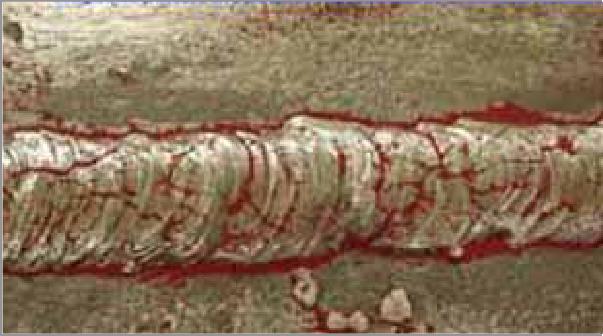
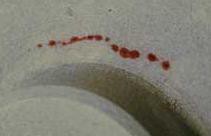
Liquid penetrant testing is one of the oldest and simplists NDT methods where its earliest versions (using kerosene and oil mixture) dates back to the 19th century. This method is used to reveal surface discontinuities by bleedout of a colored or fluorescent dye from the flaw. The technique is based on the ability
of a liquid to be drawn into a “clean” surface discontinuity by capillary action. After a period of time called the “dwell time”, excess surface penetrant is removed and a developer applied. This acts as a blotter that draws the penetrant from the discontinuity to reveal its presence.
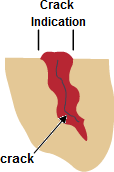 The advantage that a liquid penetrant inspection offers over an unaided visual inspection is that it makes defects easier to see for the inspector where that is done in two ways:
The advantage that a liquid penetrant inspection offers over an unaided visual inspection is that it makes defects easier to see for the inspector where that is done in two ways:
- It produces a flaw indication that is much larger and easier for the eye to detect than the flaw itself. Many flaws are so small or narrow that they are undetectable by the unaided eye (a person with a perfect vision can not resolve features smaller than 0.08 mm).
 It improves the detectability of a flaw due to the high level of contrast between the indication and the background which helps to make the indication more easily seen (such as a red indication on a white background for visable penetrant or a penetrant that glows under ultraviolate light for flourecent penetrant).
It improves the detectability of a flaw due to the high level of contrast between the indication and the background which helps to make the indication more easily seen (such as a red indication on a white background for visable penetrant or a penetrant that glows under ultraviolate light for flourecent penetrant).
Liquid penetrant testing is one of the most widely used NDT methods. Its popularity can be attributed to two main factors: its relative ease of use and its flexibility. It can be used to inspect almost any material provided that its surface is not extremely rough or porous. Materials that are commonly inspected using this method include; metals, glass, many ceramic materials, rubber and plastics.
However, liquid penetrant testing can only be used to inspect for flaws that break the surface of the sample (such as surface cracks, porosity, laps, seams, lack of fusion, etc.).
Steps of Liquid Penetrant Testing
The exact procedure for liquid penetrant testing can vary from case to case depending on several factors such as the penetrant system being used, the size and material of the component being inspected, the type of discontinuities being expected in the component and the condition and environment under which the inspection is performed. However, the general steps can be summarized as follows:
- Surface Preparation: One of the most critical steps of a liquid penetrant testing is the surface preparation. The surface must be free of oil, grease, water, or other contaminants that may prevent penetrant from entering flaws. The sample may also require etching if mechanical operations such as machining, sanding, or grit blasting have been performed. These and other mechanical operations can smear metal over the flaw opening and prevent the penetrant from entering.
- Penetrant Application: Once the surface has been thoroughly cleaned and dried, the penetrant material is applied by spraying, brushing, or immersing the part in a penetrant bath.
 Penetrant Dwell: The penetrant is left on the surface for a sufficient time to allow as much penetrant as possible to be drawn from or to seep into a defect. Penetrant dwell time is the total time that the penetrant is in contact with the part surface. Dwell times are usually recommended by the penetrant producers or required by the specification being
Penetrant Dwell: The penetrant is left on the surface for a sufficient time to allow as much penetrant as possible to be drawn from or to seep into a defect. Penetrant dwell time is the total time that the penetrant is in contact with the part surface. Dwell times are usually recommended by the penetrant producers or required by the specification being
followed. The times vary depending on the application, penetrant materials used, the material, the form of the material being inspected, and the type of discontinuity being inspected for.
Minimum dwell times typically range from five to 60 minutes. Generally,
there is no harm in using a longer penetrant dwell time as long as the penetrant is not allowed to dry. The ideal dwell time is often determined by experimentation and may be very specific to a particular application.
- Excess Penetrant Removal: This is the most delicate part of the inspection procedure because the excess penetrant must be removed from the surface of the sample while removing as little penetrant as possible from defects.
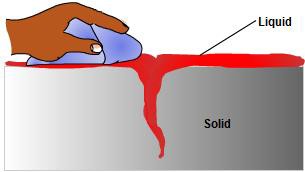 Depending on the penetrant system used, this step may involve cleaning with a solvent, direct rinsing with water, or first treating the part with an emulsifier and then rinsing with water.
Depending on the penetrant system used, this step may involve cleaning with a solvent, direct rinsing with water, or first treating the part with an emulsifier and then rinsing with water.
- Developer Application: A thin layer of developer is then applied to the sample to draw penetrant trapped in flaws back to the surface where it will be visible. Developers come in a variety of forms that may be applied by dusting (dry powders), dipping, or spraying (wet developers).
 Indication Development: The developer is allowed to stand on the part surface for a period of time sufficient to permit the extraction of the trapped penetrant out of any surface flaws. This development time is usually a minimum of 10 minutes. Significantly longer times may be necessary for tight cracks.
Indication Development: The developer is allowed to stand on the part surface for a period of time sufficient to permit the extraction of the trapped penetrant out of any surface flaws. This development time is usually a minimum of 10 minutes. Significantly longer times may be necessary for tight cracks.- Inspection: Inspection is then performed under appropriate lighting to detect indications from any flaws which may be present.
- Clean Surface: The final step in the process is to thoroughly clean the part surface to remove the developer from the parts that were found to be acceptable.
Advantages and Disadvantages
The primary advantages and disadvantages when compared to other NDT methods are:
Advantages
- High sensitivity (small discontinuities can be detected).
- Few material limitations (metallic and nonmetallic, magnetic and nonmagnetic, and conductive and nonconductive materials may be inspected).
- Rapid inspection of large areas and volumes.
- Suitable for parts with complex shapes.
- Indications are produced directly on the surface of the part and constitute a visual representation of the flaw.
- Portable (materials are available in aerosol spray cans)
- Low cost (materials and associated equipment are relatively inexpensive)
Disadvantages
- Only surface breaking defects can be detected.
- Only materials with a relatively nonporous surface can be inspected.
- Pre-cleaning is critical since contaminants can mask defects.
- Metal smearing from machining, grinding, and grit or vapor blasting must be removed.
- The inspector must have direct access to the surface being inspected.
- Surface finish and roughness can affect inspection sensitivity.
- Multiple process operations must be performed and controlled.
- Post cleaning of acceptable parts or materials is required.
- Chemical handling and proper disposal is required.
Penetrants
Penetrants are carefully formulated to produce the level of sensitivity desired by the inspector. The penetrant must possess a number of important characteristics:
- spread easily over the surface of the material being inspected to provide complete and even coverage.
- be drawn into surface breaking defects by capillary action.
- remain in the defect but remove easily from the surface of the part.
- remain fluid so it can be drawn back to the surface of the part through the drying and developing steps.
- be highly visible or fluoresce brightly to produce easy to see indications.
- not be harmful to the material being tested or the inspector.
Penetrant materials are not designed to perform the same. Penetrant manufactures have developed different formulations to address a variety of inspection applications. Some applications call for the detection of the smallest defects possible while in other
applications, the rejectable defect size may be larger. The penetrants that are used to detect the smallest defect will also produce the largest amount of irrelevant indications.
Standard specifications classify penetrant materials according to their physical characteristics and their performance.
- Penetrant materials come in two basic types:
Type 1 – Fluorescent Penetrants: they contain a dye or several dyes that fluoresce when exposed to ultraviolet radiation.
Type 2 – Visible Penetrants: they contain a red dye that provides high contrast against the white developer background.
Fluorescent penetrant systems are more sensitive than visible penetrant systems because the eye is drawn to the glow of the fluorescing indication. However, visible penetrants do not require a darkened area and an ultraviolet light in order to make an inspection.
- Penetrants are then classified by the method used to remove the excess penetrant from the part. The four methods are:
Method A – Water Washable: penetrants can be removed from the part by rinsing with water alone. These penetrants contain an emulsifying agent (detergent) that makes it possible to wash the penetrant from the part surface with water alone.
Water washable penetrants are sometimes referred to as self-emulsifying systems.
Method B – Post-Emulsifiable, Lipophilic: the penetrant is oil soluble and interacts with the oil-based emulsifier to make removal possible.
Method C – Solvent Removable: they require the use of a solvent to remove the penetrant from the part.
Method D – Post-Emulsifiable, Hydrophilic: they use an emulsifier that is a water soluble detergent which lifts the excess penetrant from the surface of the part with a water wash.
- Penetrants are then classified based on the strength or detectability of the indication that is produced for a number of very small and tight fatigue cracks. The five sensitivity levels are:
Level ½ – Ultra Low Sensitivity Level 1 – Low Sensitivity
Level 2 – Medium Sensitivity Level 3 – High Sensitivity
Level 4 – Ultra-High Sensitivity
The procedure for classifying penetrants into one of the five sensitivity levels uses specimens with small surface fatigue cracks. The brightness of the indication produced is measured using a photometer.
Developers
The role of the developer is to pull the trapped penetrant material out of defects and spread it out on the surface of the part so it can be seen by an inspector. Developers used with visible penetrants create a white background so there is a greater degree of contrast between the indication and the surrounding background. On the other hand, developers used with fluorescent penetrants both reflect and refract the incident ultraviolet light, allowing more of it to interact with the penetrant, causing more efficient fluorescence.
According to standards, developers are classified based on the method that the developer is applied (as a dry powder, or dissolved or suspended in a liquid carrier). The six standard forms of developers are:
Form a – Dry Powder Form b – Water Soluble
Form c – Water Suspendable
Form d – Nonaqueous Type 1: Fluorescent (Solvent Based) Form e – Nonaqueous Type 2: Visible Dye (Solvent Based) Form f – Special Applications
Dry Powder
Dry powder developers are generally considered to be the least sensitive but they are inexpensive to use and easy to apply. Dry developers are white, fluffy powders that can be applied to a thoroughly dry surface in a number of ways; by dipping parts in a container of developer, by using a puffer to dust parts with the developer, or placing parts in a dust cabinet where the developer is blown around. Since the powder only sticks to areas of indications since they are wet, powder developers are seldom used for visible inspections.
Water Soluble
As the name implies, water soluble developers consist of a group of chemicals that are dissolved in water and form a developer layer when the water is evaporated away. The best method for applying water soluble developers is by spraying it on the part. The part can be wet or dry. Dipping, pouring, or brushing the solution on to the surface is sometimes used but these methods are less desirable. Drying is achieved by placing the wet but well drained part in a recirculating, warm air dryer with the temperature 21°C. Properly developed parts will have an even, pale white coating over the entire surface.
Water Suspendable
Water suspendable developers consist of insoluble developer particles suspended in water. Water suspendable developers require frequent stirring or agitation to keep the particles from settling out of suspension. Water suspendable developers are applied to parts in the same manner as water soluble developers then the parts are dried using warm air.
Nonaqueous
Nonaqueous developers suspend the developer in a volatile solvent and are typically applied with a spray gun. Nonaqueous developers are commonly distributed in aerosol spray cans for portability. The solvent tends to pull penetrant from the indications by solvent action. Since the solvent is highly volatile, forced drying is not required.
Special Applications
Plastic or lacquer developers are special developers that are primarily used when a permanent record of the inspection is required.
Preparation of Part
One of the most critical steps in the penetrant inspection process is preparing the part for inspection. All coatings, such as paints, varnishes, plating, and heavy oxides must be removed to ensure that defects are open to the surface of the part. If the parts have been machined, sanded, or blasted prior to the penetrant inspection, it is possible that a thin layer of metal may have smeared across the surface and closed off defects. Also, some cleaning operations, such as steam cleaning, can cause metal smearing in softer materials. This layer of metal smearing must be removed before inspection.
Penetrant Application and Dwell Time
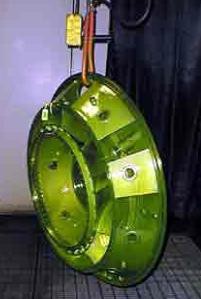
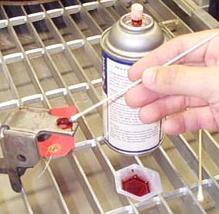
The penetrant material can be applied in a number of different ways, including spraying, brushing, or immersing the parts in a penetrant bath. Once the part is covered in penetrant it must be allowed to dwell so the penetrant has time to enter any defect that
is present.
There are basically two dwell mode options:
- Immersion-dwell: keeping the part immersed in the penetrant during the dwell period.
- Drain-dwell: letting the part drain during the dwell period (this method gives better sensitivity).
Penetrant Dwell Time
Penetrant dwell time is the total time that the penetrant is in contact with the part surface. The dwell time is important because it allows the penetrant the time necessary to seep or be drawn into a defect. Dwell times are usually recommended by the penetrant producers or required by the specification being followed. The time required to fill a flaw depends on a number of variables which include:
- The surface tension of the penetrant.
- The contact angle of the penetrant.
- The dynamic shear viscosity of the penetrant.
- The atmospheric pressure at the flaw opening.
- The capillary pressure at the flaw opening.
- The pressure of the gas trapped in the flaw by the penetrant.
- The radius of the flaw or the distance between the flaw walls.
- The density or specific gravity of the penetrant.
- Microstructural properties of the penetrant.
The ideal dwell time is often determined by experimentation and is often very specific to a particular application. For example, the table shows the dwell time requirements for steel parts according to some of the commonly used specifications.
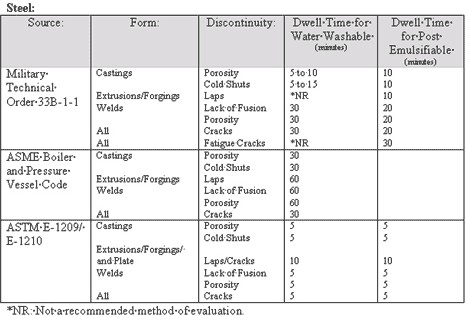
Penetrant Removal Process
The penetrant removal procedure must effectively remove the penetrant from the surface of the part without removing an appreciable amount of entrapped penetrant from the discontinuity. If the removal process extracts penetrant from the flaw, the flaw indication will be reduced by a proportional amount. If the penetrant is not effectively removed from the part surface, the contrast between the indication and the background will be reduced.
Removal Method
As mentioned previously, penetrant systems are classified into four types according to the method used for excess penetrant removal.
- Method A: Water-Washable
- Method B: Post-Emulsifiable, Lipophilic
- Method C: Solvent Removable
- Method D: Post-Emulsifiable, Hydrophilic
Method C, Solvent Removable, is used primarily for inspecting small localized areas. This method requires hand wiping the surface with a cloth moistened with the solvent remover, and is, therefore, too labor intensive for most production situations.
Method A, Water-Washable, is the most economical to apply of the different methods and it is easy to use. Water-washable or self-emulsifiable penetrants contain an emulsifier as an integral part of the formulation. The excess penetrant may be removed from the object surface with a simple water rinse.
When removal of the penetrant from the defect due to over-washing of the part is a concern, a post-emulsifiable penetrant system can be used. The post-emulsifiable methods are generally only used when very high sensitivity is needed. Post- emulsifiable penetrants require a separate emulsifier to breakdown the penetrant and make it water washable. The part is usually immersed in the emulsifier but hydrophilic emulsifiers may also be sprayed on the object. Brushing the emulsifier on to the part is not recommended either because the bristles of the brush may force emulsifier into discontinuities, causing the entrapped penetrant to be removed. The emulsifier is allowed sufficient time to react with the penetrant on the surface of the part but not given time to make its way into defects to react with the trapped penetrant.
Controlling the reaction time is of essential importance when using a post-emulsifiable system. If the emulsification time is too short, an excessive amount of penetrant will be left on the surface, leading to high background levels. If the emulsification time is too long, the emulsifier will react with the penetrant entrapped in discontinuities, making it possible to deplete the amount needed to form an indication.
The hydrophilic post-emulsifiable method (Method D) is more sensitive than the lipophilic post-emulsifiable method (Method B). The major advantage of hydrophilic emulsifiers is that they are less sensitive to variation in the contact and removal time.
When using an emulsifiable penetrant is used, the penetrant inspection process includes the following steps (extra steps are underlined): 1. pre-clean part, 2. apply penetrant and allow to dwell, 3. pre-rinse to remove first layer of penetrant, 4. apply hydrophilic emulsifier and allow contact for specified time, 5. rinse to remove excess penetrant, 6. dry part, 7. apply developer and allow part to develop, and 8. inspect.
Rinse Method and Time for Water-Washable Penetrants
The method used to rinse the excess penetrant from the object surface and the time of the rinse should be controlled so as to prevent over-washing. It is generally
recommended that a coarse spray rinse or an air-agitated, immersion wash tank be used. When a spray is being used, it should be directed at a 45° angle to the part surface so as to not force water directly into any discontinuities that may be present. The spray or immersion time should be kept to a minimum through frequent inspections of the remaining background level.
Hand Wiping of Solvent Removable Penetrants
When a solvent removable penetrant is used, care must also be taken to carefully remove the penetrant from the part surface while removing as little as possible from the flaw. The first step in this cleaning procedure is to dry wipe the surface of the part in one direction using a white, lint-free, cotton rag. One dry pass in one direction is all that should be used to remove as much penetrant as possible. Next, the surface should be wiped with one pass in one direction with a rag moistened with cleaner. One dry pass followed by one damp pass is all that is recommended. Additional wiping may sometimes be necessary; but keep in mind that with every additional wipe, some of the entrapped penetrant will be removed and inspection sensitivity will be reduced.
Use and Selection of a Developer
The use of developer is almost always recommended. The output from a fluorescent penetrant is improved significantly when a suitable powder developer is used. Also, the use of developer can have a dramatic effect on the probability of detection of an inspection.
Nonaqueous developers are generally recognized as the most sensitive when properly applied. However, if the thickness of the coating becomes too great, defects can be masked. The relative sensitivities of developers and application techniques as ranked in Volume II of the Nondestructive Testing Handbook are shown in the table below.
| Ranking 1 2 3 4 5 6 7 8 9 10 | Developer Form Nonaqueous, Wet Solvent Plastic Film Water-Soluble Water-Suspendable Water-Soluble Water-Suspendable Dry Dry Dry Dry | Method of Application Spray Spray Spray Spray Immersion Immersion Dust Cloud (Electrostatic) Fluidized Bed Dust Cloud (Air Agitation) Immersion (Dip) |
The following table lists the main advantages and disadvantages of the various developer types.
| Developer | Advantages | Disadvantages |
| Dry | Indications tend to remain brighter and more distinct over time Easily to apply | Does not form contrast background so cannot be used with visible systems Difficult to assure entire part surface has been coated |
| Soluble | Ease of coating entire part White coating for good contrast can be produced which work well for both visible and fluorescent systems | Coating is translucent and provides poor contrast (not recommended for visual systems) Indications for water washable systems are dim and blurred |
| Suspendable | Ease of coating entire part Indications are bright and sharp White coating for good contrast can be produced which work well for both visible and fluorescent systems | Indications weaken and become diffused after time |
| Nonaqueous | Very portable Easy to apply to readily accessible surfaces White coating for good contrast can be produced which work well for both visible and fluorescent systems Indications show-up rapidly and are well defined Provides highest sensitivity | Difficult to apply evenly to all surfaces More difficult to clean part after inspection |
Quality & Process Control
Quality control of the penetrant inspection process is essential to get good and consistent results. Since several steps and materials are involved in the inspection process, there are quality control procedures for each of them.
Temperature Control
The temperature of the penetrant materials and the part being inspected can have an effect on the results. Temperatures from 27 to 49°C are reported in the literature to produce optimal results. Many specifications allow testing in the range of 4 to 52°C. Raising the temperature beyond this level will significantly raise the speed of evaporation of penetrants causing them to dry out quickly.
Since the surface tension of most materials decrease as the temperature increases, raising the temperature of the penetrant will increase the wetting of the surface and the capillary forces. Of course, the opposite is also true, so lowering the temperature will have a negative effect on the flow characteristics.
Penetrant Quality Control
The quality of a penetrant inspection is highly dependent on the quality of the penetrant materials used. Only products meeting the requirements of an industry specification, such as AMS 2644, should be used. Deterioration of new penetrants primarily results from aging and contamination. Virtually all organic dyes deteriorate over time, resulting in a loss of color or fluorescent response, but deterioration can be slowed with proper storage. When possible, keep the materials in a closed container and protect from freezing and exposure to high heat.
Contamination can occur during storage and use. Of course, open tank systems are much more susceptible to contamination than are spray systems. Regular checks must be performed to ensure that the material performance has not degraded. When the penetrant is first received from the manufacturer, a sample of the fresh solution should be collected and stored as a standard for future comparison. The standard specimen should be stored in a sealed, opaque glass or metal container. Penetrants that are in-use should be compared regularly to the standard specimen to detect any changes in properties or performance.
Dwell Quality Control
Dwell times are usually recommended by the penetrant producer or required by the specification being followed. The only real quality control required in the dwell step of the process is to ensure that a minimum dwell time is reached. There is no harm in allowing a penetrant to dwell longer than the minimum time as long as the penetrant is not allowed to dry on the part.
Emulsifier Path Quality Control
Quality control of the emulsifier bath is important and it should be performed per the requirements of the applicable specification.
Lipophilic Emulsifiers
Lipophilic emulsifiers mix with penetrants but when the concentration of penetrant contamination in the emulsifier becomes too great, the mixture will not function effectively as a remover. Standards require that lipophilic emulsifiers be capable of 20% penetrant contamination without a reduction in performance. When the cleaning action of the emulsifier becomes less than that of new material, it should be replaced.
Hydrophilic Emulsifiers
Hydrophilic emulsifiers have less tolerance for penetrant contamination. The penetrant tolerance varies with emulsifier concentration and the type of contaminating penetrant. In some cases, as little as 1% (by volume) penetrant contamination can seriously affect the performance of an emulsifier.
Emulsifier Concentration and Contact Time
The optimal emulsifier contact time is dependent on a number of variables that include the emulsifier used, the emulsifier concentration, the surface roughness of the part being inspected, and other factors. Usually some experimentation is required to select the proper emulsifier contact time.
Wash Quality Control
The wash temperature, pressure and time are three parameters that are typically controlled in penetrant inspection process specification. A coarse spray or an immersion wash tank with air agitation is often used. When the spray method is used, the water pressure is usually limited to 276 kPa. The temperature range of the water is
usually specified as a wide range (e.g., 10 to 38°C). The wash time should only be as long as necessary to decrease the background to an acceptable level. Frequent visual checks of the part should be made to determine when the part has been adequately rinsed.
Drying Process Quality Control
The temperature used to dry parts after the application of an aqueous wet developer or prior to the application of a dry powder or a nonaqueous wet developer, must be controlled to prevent drying in the penetrant in the flaw. To prevent harming the penetrant material, drying temperature should be kept to less than 71°C. Also, the drying time should be limited to the minimum length necessary to thoroughly dry the component being inspected.
Developer Quality Control
The function of the developer is very important in a penetrant inspection. In order to accomplish its functions, a developer must adhere to the part surface and result in a uniform, highly porous layer with many paths for the penetrant to be moved due to capillary action. Developers are either applied wet or dry, but the desired end result is always a uniform, highly porous, surface layer. Since the quality control requirements for each of the developer types is slightly different, they will be covered individually.
Dry Powder Developer
A dry powder developer should be checked daily to ensure that it is fluffy and not caked. It should be similar to fresh powdered sugar and not granulated like powdered soap. It should also be relatively free from specks of fluorescent penetrant material from previous inspection. This check is performed by spreading a sample of the developer out and examining it under UV light.
When using the developer, a light coat is applied by immersing the test component or dusting the surface. After the development time, excessive powder can be removed by gently blowing on the surface with air not exceeding 35 kPa.
Wet Soluble/Suspendable Developer
Wet soluble developer must be completely dissolved in the water and wet suspendable developer must be thoroughly mixed prior to application. The concentration of powder in the carrier solution must be controlled in these developers.
The concentration should be checked at least weekly using a hydrometer to make sure it meets the manufacturer’s specification. To check for contamination, the solution should be examined weekly using both white light and UV light. Some specifications require that a clean aluminum panel be dipped in the developer, dried, and examined for indications of contamination by fluorescent penetrant materials.
These developers are applied by spraying, flowing or immersing the component. They should never be applied with a brush. Care should be taken to avoid a heavy accumulation of the developer solution in crevices and recesses.
Solvent Suspendable
Solvent suspendable developers are typically supplied in sealed aerosol spray cans. Since the developer solution is in a sealed vessel, direct check of the solution is not possible. However, the way that the developer is dispensed must be monitored. The spray developer should produce a fine, even coating on the surface of the part. Make sure the can is well shaken and apply a thin coating to a test article. If the spray produces spatters or an uneven coating, the can should be discarded.
When applying a solvent suspendable developer, it is up to the inspector to control the thickness of the coating. With a visible penetrant system, the developer coating must be thick enough to provide a white contrasting background but not heavy enough to mask indications. When using a fluorescent penetrant system, a very light coating should be used. The developer should be applied under white light and should appear evenly transparent.
Development Time
Parts should be allowed to develop for a minimum of 10 minutes and no more than 2 hours before inspecting.
Lighting Quality Control
Proper lighting is of great importance when visually inspecting a surface for a penetrant indication. Obviously, the lighting requirements are different for an inspection conducted using a visible dye penetrant than they are for an inspection conducted using a fluorescent dye penetrant.
Lighting for Visible Dye Penetrant Inspections
When using a visible penetrant, the intensity of the white light is of principal importance. Inspections can be conducted using natural lighting or artificial lighting.
However, since natural daylight changes from time to time, the use of artificial lighting is recommended to get better uniformity. Artificial lighting should be white whenever possible (halogen lamps are most commonly used). The light intensity is required to be 100 foot-candles at the surface being inspected.
Lighting for Fluorescent Penetrant Inspections
Fluorescent penetrant dyes are excited by UV light of 365nm wavelength and emit visible light somewhere in the green-yellow range between 520 and 580nm. The source of ultraviolet light is often a mercury arc lamp with a filter. The lamps emit many wavelengths and a filter is used to remove all but the UV and a small amount of visible light between 310 and 410nm. Visible light of wavelengths above 410nm interferes with contrast, and UV emissions below 310nm include some hazardous wavelengths.
Standards and procedures require verification of filter condition and light intensity. The black light filter should be clean and the light should never be used with a cracked filter. Most UV light must be warmed up prior to use and should be on for at least 15 minutes before beginning an inspection. Since fluorescent brightness is linear with respect to ultraviolet excitation, a change in the intensity of the light (from age or damage) and a change in the distance of the light source from the surface being inspected will have a direct impact on the inspection. For UV lights used in component evaluations, the normally accepted intensity is 1000 µW/cm2 at 38cm distance from the filter face. The required check should be performed when a new bulb is installed, at startup of the inspection cycle, if a change in intensity is noticed, or every eight hours of continuous use.
When performing a fluorescent penetrant inspection, it is important to keep white light to a minimum as it will significantly reduce the inspector’s ability to detect fluorescent indications. Light levels of less than 2 foot-candles are required by most procedures. When checking black light intensity a reading of the white light produced by the black light may be required to verify white light is being removed by the filter.
Light Measurement
Light intensity measurements are made using a radiometer (an instrument that transfers light energy into an electrical current). Some radiometers have the ability to measure both black and white light, while others require a separate sensor for each measurement. Whichever type is used, the sensing area should be clean and free of any materials that could reduce or obstruct light reaching the sensor. Radiometers are
relatively unstable instruments and readings often change considerable over time. Therefore, they should be calibrated at least every six months.
System Performance Check
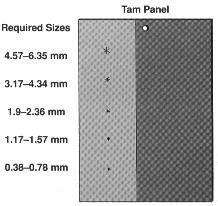 A system performance check is typically required daily, at the reactivation of a system after maintenance or repairs, or any time the system is suspected of being out of control. System performance checks involve processing a test specimen with known defects to determine if the process will reveal discontinuities of the size required. The specimen must be processed following the same procedure used to process production parts. The ideal specimen is a production item that has natural defects of the minimum acceptable size. As with penetrant inspections in general, results are directly dependent on the skill of the operator and, therefore, each
A system performance check is typically required daily, at the reactivation of a system after maintenance or repairs, or any time the system is suspected of being out of control. System performance checks involve processing a test specimen with known defects to determine if the process will reveal discontinuities of the size required. The specimen must be processed following the same procedure used to process production parts. The ideal specimen is a production item that has natural defects of the minimum acceptable size. As with penetrant inspections in general, results are directly dependent on the skill of the operator and, therefore, each
operator should process a test specimen.
There are some universal test specimens that can be used if a standard part is not available. The most commonly used test specimen is the TAM or PSM panel which is used for fluorescent penetrant systems. These panels are usually made of stainless steel that has been chrome plated on one half and surfaced finished on the other half to produce the desired
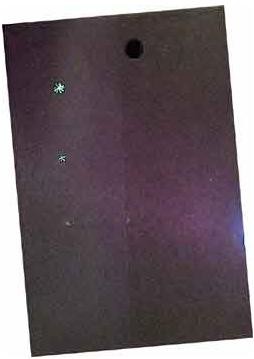 roughness. The chrome plated section is impacted from the back side to produce a starburst set of cracks in the chrome. There are five impacted areas with a range of different crack sizes corresponding to the five levels of sensitivity.
roughness. The chrome plated section is impacted from the back side to produce a starburst set of cracks in the chrome. There are five impacted areas with a range of different crack sizes corresponding to the five levels of sensitivity.
Care of system performance check specimens is critical. Specimens should be handled carefully to avoid damage. They should be cleaned thoroughly between uses and storage in a solvent is generally recommended. Before processing a specimen, it should be inspected under UV light to make sure that it is clean and not already producing an indication.
Nature of the Defect
The nature of the defect can have a large effect on sensitivity of a liquid penetrant inspection. Sensitivity is defined as the smallest defect that can be detected with a high degree of reliability. Typically, the crack length at the sample surface is used to define
size of the defect. However, the crack length alone does not determine whether a flaw will be seen or go undetected. The volume of the defect is likely to be the more important feature. The flaw must be of sufficient volume so that enough penetrant will bleed back out to a size that is detectable by the eye or that will satisfy the dimensional thresholds of fluorescence. The figure shows an example of fluorescent penetrant inspection probability of detection (POD) curve as a function of crack length.
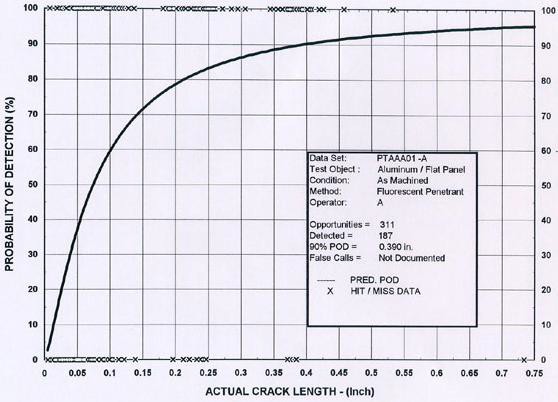
In general, penetrant testing is more effective at finding:
- Small round defects than small linear defects.
- Deeper flaws than shallow flaws.
- Flaws with a narrow opening at the surface than wide open flaws.
- Flaws on smooth surfaces than on rough surfaces.
- Flaws with rough fracture surfaces than smooth fracture surfaces.
- Flaws under tensile or no loading than flaws under compression loading.
Health and Safety Precautions
When proper health and safety precautions are followed, liquid penetrant inspection operations can be completed without harm to inspection personnel. However, there is a number of health and safety related issues that need to be taken in consideration.
The most common of those are discussed here.
Chemical Safety
Whenever chemicals must be handled, certain precautions must be taken. Before working with a chemical of any kind, it is highly recommended that the material safety data sheets (MSDS) be reviewed so that proper chemical safety and hygiene practices can be followed. Some of the penetrant materials are flammable and, therefore, should be used and stored in small quantities. They should only be used in a well ventilated area and ignition sources avoided. Eye protection should always be worn to prevent contact of the chemicals with the eyes. Gloves and other protective clothing should be worn to limit contact with the chemicals.
Ultraviolet Light Safety
Ultraviolet (UV) light has wavelengths ranging from 180 to 400 nanometers. These wavelengths place UV light in the invisible part of the electromagnetic spectrum between visible light and X-rays. The most familiar source of UV radiation is the sun and is necessary in small doses for certain chemical processes to occur in the body. However, too much exposure can be harmful to the skin and eyes. The greatest threat with UV light exposure is that the individual is generally unaware that the damage is occurring. There is usually no pain associated with the injury until several hours after the exposure. Skin and eye damage occurs at wavelengths around 320 nm and shorter which is well below the 365 nm wavelength, where penetrants are designed to fluoresce. Therefore, UV lamps sold for use in penetrant testing are almost always filtered to remove the harmful UV wavelengths. The lamps produce radiation at the harmful wavelengths so it is essential that they be used with the proper filter in place and in good condition.
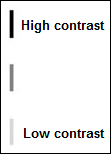
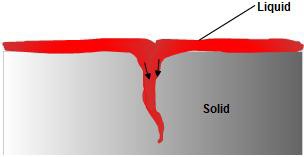 Penetrant Dwell: The penetrant is left on the surface for a sufficient time to allow as much penetrant as possible to be drawn from or to seep into a defect. Penetrant dwell time is the total time that the penetrant is in contact with the part surface. Dwell times are usually recommended by the penetrant producers or required by the specification being
Penetrant Dwell: The penetrant is left on the surface for a sufficient time to allow as much penetrant as possible to be drawn from or to seep into a defect. Penetrant dwell time is the total time that the penetrant is in contact with the part surface. Dwell times are usually recommended by the penetrant producers or required by the specification being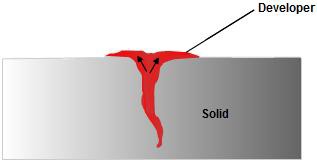 Indication Development: The developer is allowed to stand on the part surface for a period of time sufficient to permit the extraction of the trapped penetrant out of any surface flaws. This development time is usually a minimum of 10 minutes. Significantly longer times may be necessary for tight cracks.
Indication Development: The developer is allowed to stand on the part surface for a period of time sufficient to permit the extraction of the trapped penetrant out of any surface flaws. This development time is usually a minimum of 10 minutes. Significantly longer times may be necessary for tight cracks.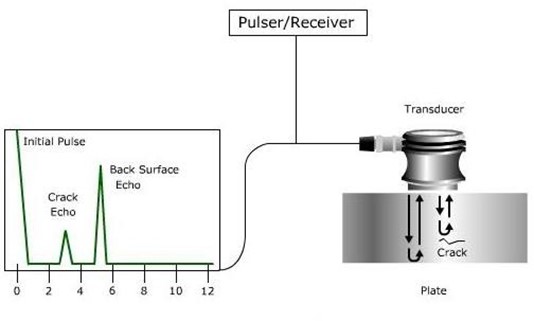
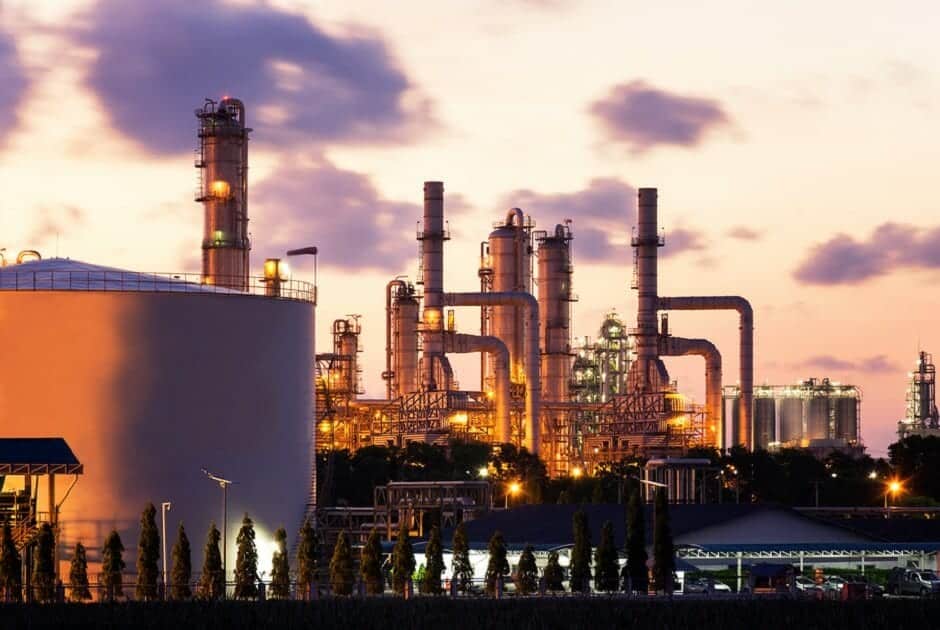
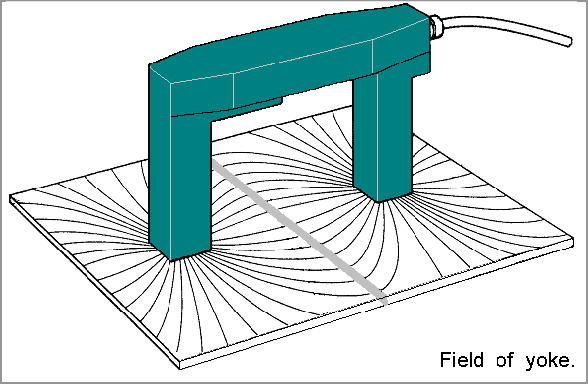

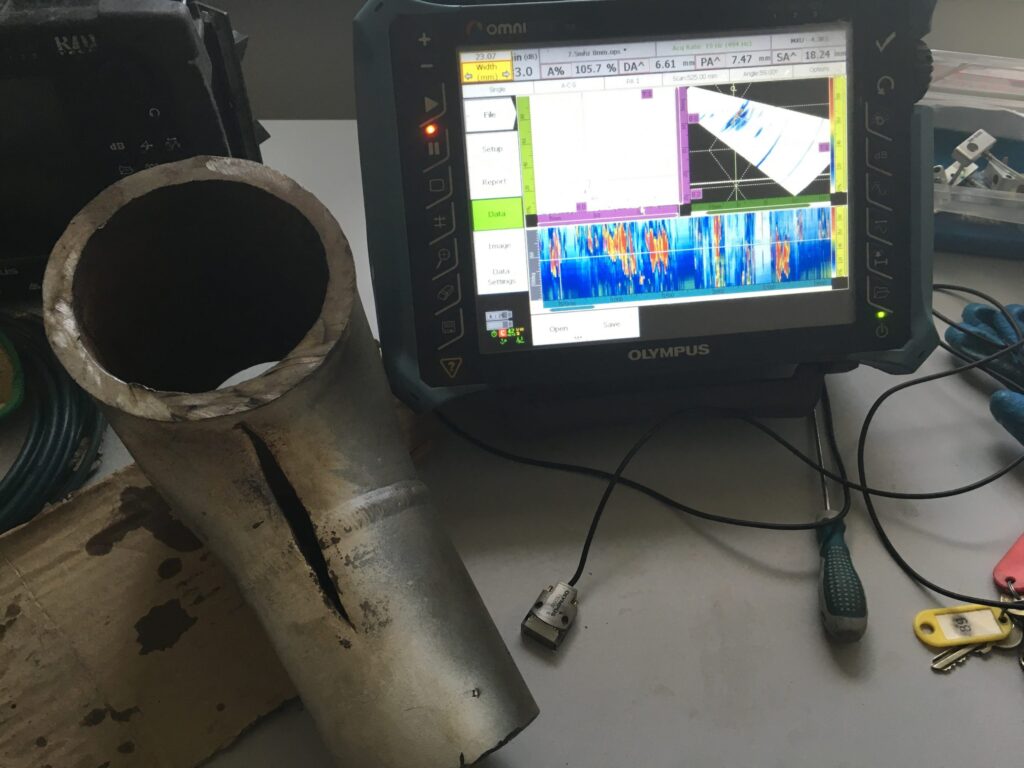
Responses